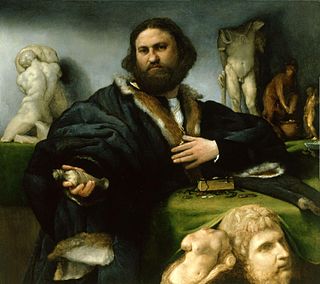 W
WThe Dutch Gift of 1660 was a collection of 28 mostly Italian Renaissance paintings and 12 classical sculptures, along with a yacht, the Mary, and furniture, which was presented to King Charles II of England by the States-General of the Netherlands in 1660. The collection was given to Charles II to mark his return to power in the English Restoration, before which Charles had spent many years in exile in Paris, Cologne, and the Spanish Netherlands, during the rule of the English Commonwealth. It was intended to strengthen diplomatic relations between England and the Republic, but only a few years after the gift the two nations would be at war again in the Second Anglo-Dutch War of 1665–67.
 W
WThe Adoration of the Shepherds by Giovanni Cariani is a panel painting of about 1515-1517, now in the Royal Collection of the United Kingdom. The painting is somewhat damaged, and also seems to have been subject to significant changes of intention during the process of painting. It was one of the large group of paintings bought by Charles I of England from the collection of Vincenzo II, last of the Gonzaga Dukes of Mantua in 1628. The painted surface measures 73.6 cm × 120.3 cm.
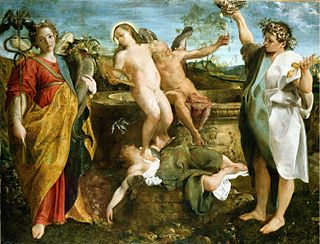 W
WAn Allegory of Truth and Time is a 1584-1585 oil on canvas painting by Annibale Carracci, now on display in Hampton Court as part fo the Royal Collection.
 W
WApollo and Diana or The Liberal Arts presented to King Charles and Henrietta Maria is a 1628 painting by Gerard van Honthorst, now on the Queen's Staircase at Hampton Court Palace as part of the Royal Collection.
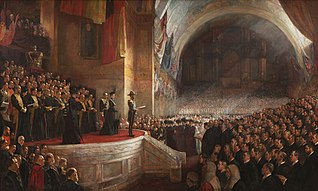 W
WThe Opening of the First Parliament of the Commonwealth of Australia by H.R.H. The Duke of Cornwall and York, May 9, 1901, more commonly known in Australia as The Big Picture, is a 1903 painting by the Australian artist Tom Roberts. The painting, measuring 304.5 by 509.2 centimetres, or roughly 10 by 17 feet, depicts the opening of the first Parliament of Australia at the Royal Exhibition Building in Melbourne on 9 May 1901.
 W
WBonaparte Crossing the Alps is an 1848–1850 oil-on-canvas portrait of Napoleon Bonaparte, by French artist Paul Delaroche. The painting depicts Bonaparte leading his army through the Alps on a mule, a journey Napoleon and his army of soldiers made in the spring of 1800, in an attempt to surprise the Austrian army in Italy. The two main versions of this painting that exist are in the Louvre in Lens and the Walker Art Gallery in Liverpool, England. Queen Victoria also obtained a reduced version of it.
 W
WBoy Peeling Fruit is a painting by the Italian Baroque master Michelangelo Merisi da Caravaggio (1571–1610) painted circa 1592–1593.
 W
WThe Calling of Saints Peter and Andrew is a painting by the Italian Baroque master Caravaggio. It takes its theme from a passage in the Gospel of Matthew describing the moment when Christ called the two brothers Simon – later known as Peter – and Andrew, to be his disciples:As Jesus walked by the Sea of Galilee, he saw two brothers, Simon, who is called Peter, and Andrew his brother, casting a net into the sea – for they were fishermen. And he said to them, "Follow me, and I will make you fishers of men." Immediately, they left their nets and followed him. Matthew 4:18–20
 W
WCardplayers in a Sunlit Room (1658) is an oil on canvas painting by the Dutch painter Pieter de Hooch; it is an example of Dutch Golden Age painting and is now in the Royal Collection at Windsor Castle.
 W
WCharles I in Three Positions, also known as the Triple Portrait of Charles I, is an oil painting of Charles I of England by Flemish artist Sir Anthony van Dyck, showing the king from three viewpoints: left full profile, face on, and right three-quarter profile. Painted in 1635 or 1636, it is currently part of the Royal Collection. The colours of the costumes and pattern of the lace collars are different in each portrait, though the blue riband of the Order of the Garter is present in all three.
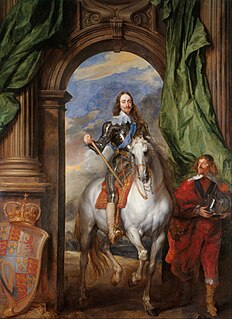 W
WCharles I with M. de St Antoine is an oil painting on canvas by the Flemish painter Anthony van Dyck, depicting Charles I on horseback, accompanied by his riding master, Pierre Antoine Bourdon, Seigneur de St Antoine.
 W
WThe Chinese Convert is a famous 1687 painting by Godfrey Kneller depicting the Chinese man Michael Alphonsius Shen Fu-Tsung.
 W
WCupid and Psyche is an oil on canvas painting by Anthony van Dyck. It is now in the Royal Collection and shown in Kensington Palace.
 W
WDiana is a 1637 painting of Diana by Simon Vouet. It was produced in Paris and sent to England as part of the dowry of Louis XIII's sister Henrietta Maria of France on her marriage to Charles I of England. It is still in the Royal Collection and now hangs in the Cumberland Gallery at Hampton Court Palace.
 W
WEsther before Ahasuerus is a large painting of 1546–47 by the Venetian painter Tintoretto showing a scene from the Greek addition to the Book of Esther, where Queen Esther faints during a bold intervention with her husband King Ahasuerus of Persia. In oil on canvas, it measures 207.7 by 275.5 centimetres. Since the 1620s it has been in the Royal Collection of the United Kingdom, and in 2019 it hung in the King's Gallery in Kensington Palace, London.
 W
WThe Holy Family with Saint Jerome is a 68 by 56 cm oil on poplar panel painting by Correggio. It dates to around 1515 and is now displayed in the East Closet of Hampton Court Palace as part of the Royal Collection. It has similarities with the Holy Family with the Infant Saint John the Baptist and so it probably dates to around the time Correggio painted the frescoes in the Camera di San Paolo or possibly slightly earlier. It shows the Holy Family and saint Jerome.
 W
WInfanta Isabella Clara Eugenia and Infanta Catherine Michelle is a 1569-1570 oil on canvas painting by Sofonisba Anguissola, now in the Royal Collection at Buckingham Palace. It shows Isabella Clara Eugenia and Catherine Michelle, two daughters of Philip II of Spain and his third wife Elizabeth of Valois.
 W
WJoseph and Potiphar's Wife is a painting by Orazio Gentileschi, painted around 1630-1632 during his time in Charles I's court. Along with The Finding of Moses and an Apollo and the Muses (Private Collection), it was created for Queen Henrietta to hang in the Queen's House in Greenwich.
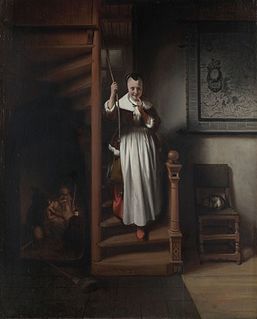 W
WThe Listening Housewife (1655) is an oil on panel painting by the Dutch painter Nicolaes Maes. It is an example of Dutch Golden Age painting and is part of the collection of the Royal Collection of the United Kingdom.
 W
WThe Madonna and Sleeping Child with the Infant St John the Baptist or Il Silenzio is oil on canvas painting by Annibale Carracci, now in the Royal Collection. It is currently on display in Hampton Court Palace.
 W
WSeveral oil-on-oak-panel versions of The Massacre of the Innocents were painted by 16th-century Netherlandish painters Pieter Bruegel the Elder and his son Pieter Brueghel the Younger. The work translates the Biblical account of the Massacre of the Innocents into a winter scene in the Netherlands in the prelude to the Dutch Revolt against Spanish rule, also known as the Eighty Years' War.
 W
WThe Muses is a 1578 painting by Tintoretto showing the Muses from Greek mythology.
 W
WThe Music Lesson, Woman Seated at a Virginal or A Lady at the Virginals with a Gentleman by Johannes Vermeer is a painting of a young female pupil receiving a music lesson from a man. The man's mouth is slightly agape giving the impression that he is singing along with the music that the young girl is playing. This suggests that there is a relationship between the two figures and the idea of love and music being bridged together. This was a common theme among Netherlandish art in this time period. Vermeer consistently used the same objects within his paintings such as the draped rug, the white water jug, various instruments, tiled floor and windows that convey light and shadows. This is one of few paintings produced by Vermeer which were kept in his home until his death in 1675 when his family was forced to sell them. It became a part of the Royal Collection, and it is currently on display in the Picture Gallery at Buckingham Palace in London.
 W
WPortrait of a Young Man is a c.1505 oil on panel painting by Giovanni Bellini. It is the latest surviving portrait by the artist, drawing on the work of Antonello da Messina and Dutch painters of the time. It is also the only portrait in which he included a landscape behind the sitter. He signed it on a cartouche on the trompe l'oeil marble parapet in the foreground.
 W
WThe Portrait of Andrea Odoni is a painting by the Italian High Renaissance painter Lorenzo Lotto dated 1527, now in the Royal Collection of the United Kingdom. In early 2019 it was on loan to the National Gallery for an exhibition of Lotto's portraits.
 W
WPortrait of Henry VIII is a lost work by Hans Holbein the Younger depicting Henry VIII. It was destroyed by fire in 1698, but is still well known through many copies. It is one of the most iconic images of Henry and is one of the most famous portraits of any British monarch. It was originally created in 1536–1537 as part of a mural showing the Tudor dynasty at the Palace of Whitehall, London.
 W
WRamsgate Sands, also known as Life at the Seaside, is an oil-on-canvas painting by William Powell Frith, made in 1852 to 1854, which depicts a beach scene in Ramsgate. The painting was Frith's first great commercial success: it was exhibited at the Royal Academy summer exhibition in 1854, and bought by Queen Victoria. Frith made a series of similar pictures, showing groups of people in contemporary scenes, including The Derby Day of 1858, and The Railway Station of 1862 and Private View at the Royal Academy of 1883.
 W
WThe Raphael Cartoons are seven large cartoons for tapestries, belonging to the British Royal Collection but since 1865 on loan to the Victoria and Albert Museum in London, designed by the High Renaissance painter Raphael in 1515–16 and showing scenes from the Gospels and Acts of the Apostles. They are the only surviving members of a set of ten cartoons commissioned by Pope Leo X for the Sistine Chapel tapestries for the Sistine Chapel in the Vatican Palace, which are still hung below Michelangelo's famous ceiling. Reproduced in the form of prints, the tapestries rivalled Michelangelo's ceiling as the most famous and influential designs of the Renaissance, and were well known to all artists of the Renaissance and Baroque. Admiration of them reached its highest pitch in the 18th and 19th centuries; they were described as "the Parthenon sculptures of modern art".
 W
WSaint Martin and the Beggar is a c.1618 painting of Saint Martin of Tours by the Flemish painter Anthony van Dyck. The painting portrays the saint sharing his cloak with a beggar.
 W
WSelf-Portrait is a 1623 self-portrait in oils on canvas by Peter Paul Rubens, signed and dated by the artist. He produced it to send to Charles Prince of Wales and it is still in the Royal Collection.
 W
WSelf-Portrait as the Allegory of Painting, also known as Autoritratto in veste di Pittura or simply La Pittura, was painted by the Italian Baroque artist Artemisia Gentileschi. The oil-on-canvas painting measures 96.5 by 73.7 centimetres and was probably produced during Gentileschi's stay in England between 1638 and 1639. It was in the collection of Charles I and was returned to the Royal Collection at the Restoration (1660) and remains there. In 2015 it was put on display in the "Cumberland Gallery" in Hampton Court Palace.
 W
WShepherd with a flute, or Boy with a Pipe, is a painting in oil on canvas of perhaps 1510–1515, in recent decades usually attributed to Titian, though in the past often to Giorgione. It is now in the Royal Collection, and in 2018 was in the King's Closet at Windsor Castle. Since at least 1983 it has been called Boy with a Pipe by the Royal Collection; previous titles the collection recognise include Shepherd with a pipe, and The Shepherd.
 W
WThe Shipbuilder and his Wife is a 1633 painting by Rembrandt. The sitters were identified in 1970 as Jan Rijcksen (1560/2–1637) and his wife Griet Jans Rijcksen. Rijcksen was a shareholder in the Dutch East India Company, and became its master shipbuilder in 1620. The painting has been in the Royal Collection since 1811.
 W
WStanding Cavalier is a painting by Judith Leyster in the Royal Collection. It is the only painting by Leyster with a provenance that reaches back to the 18th-century.
 W
WThe Three Eldest Children of Charles I is an oil painting on canvas by Anthony van Dyck, produced between November 1635 and March 1636 and still in the Royal Collection. Numerous studio copies were made of this painting.
 W
WThe Tribuna of the Uffizi (1772–1778) by Johan Zoffany is a painting of the north-east section of the Tribuna room in the Uffizi in Florence, Italy. The painting is part of the United Kingdom's Royal Collection.
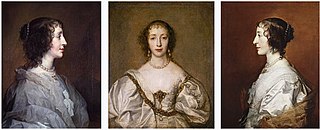 W
WThe Triple Portrait of Henrietta Maria is a 1638 painting by Antony van Dyck showing Henrietta Maria, wife of Charles I of England. Charles had previously commissioned van Dyck to produce a triple portrait of himself to send to Italy so that Bernini could produce a bust of him. When the bust arrived, the queen ordered a bust of herself by Bernini and commissioned van Dyck to produce a similar triple portrait. The left-facing profile and full-on view are in the Royal Collection, whilst the right-facing profile is probably the portrait of the queen now in the Memphis Brooks Museum of Art.
 W
WThe Triumphs of Caesar are a series of nine large paintings created by the Italian Renaissance artist Andrea Mantegna between 1484 and 1492 for the Gonzaga Ducal Palace, Mantua. They depict a triumphal military parade celebrating the victory of Julius Caesar in the Gallic Wars. Acknowledged from the time of Mantegna as his greatest masterpiece, they remain the most complete pictorial representation of a Roman triumph ever attempted and together they form the world's largest metric area of Italian Renaissance paintings outside Italy. Acquired by Charles I in 1629, they now form part of the Royal Collection at Hampton Court Palace near London, where they occupy a special gallery, with a new continuous frame intended to capture their original setting, mounted into panelling.
 W
WThe Windsor Beauties are a famous collection of paintings by Sir Peter Lely, painted in the early to mid-1660s, that depict ladies of the court of King Charles II, some of whom were his mistresses. The name stems from the original location of the collection, which was housed at Windsor Castle. They can now be seen at Hampton Court Palace.